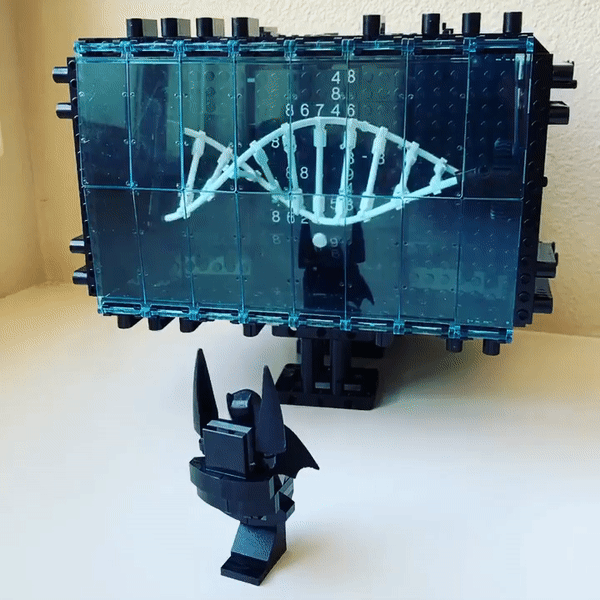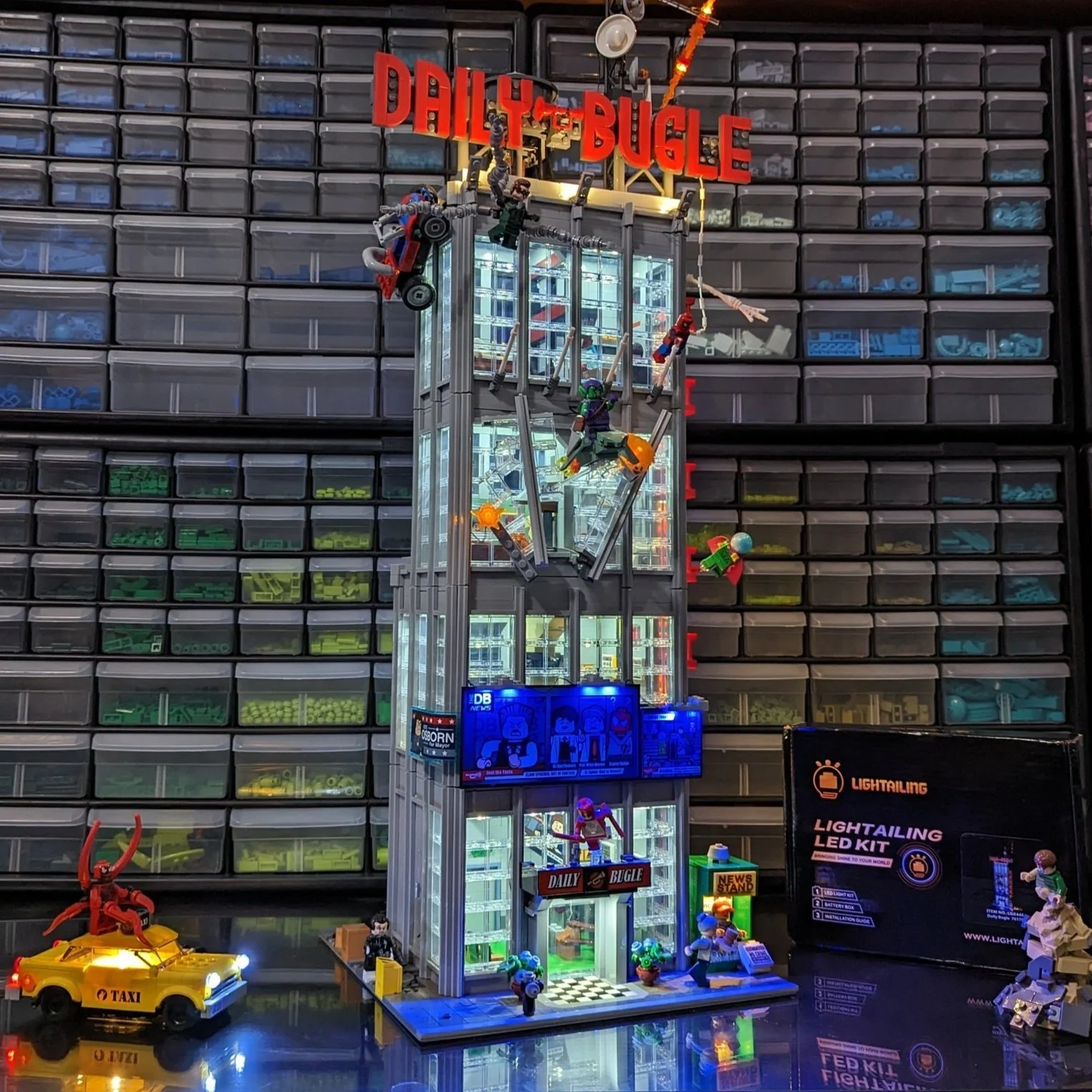Holy FUNctions, Batman! An Interview with Rian Zagelow
/In the before times, I was in Portland at Bricks Cascade 2020, when I saw the largest Batwing I ever saw (long before LEGO launched their official Batwing set). The Batwing was bigger than the UCS Millennium Falcon and way cooler, but what happened next blew me away: the entire Batwing spun, along with a motorized background.
Millennium Batwing - @brickbatdad
It didn’t surprise me (or anyone), that builder Rian Zagelow (@brickbatdad) won the “Pop Culture: Sophisticatedly Super” award for his “Millennium Batwing.” But it clued me into a trend.
I’ve been to many conventions and I’ve won my share of awards. The merit of LEGO convention awards is a whole other massive topic to cover at a later date, but generally speaking, award-winning LEGO builders tend to do one or more of the following to stand out:
Build really BIG
Build really detailed
Build really cool ideas
Build really neat motions
While it’s different for everyone, I’ve ranked those in order of easiest to hardest for me any my builds. This is why Rian's build was so impressive to me because it nailed all four categories: it was huge, detailed, neat and spun!
As impressive as the Millennium Batwing was, a few weeks ago I saw this other build from Rian that absolutely melted my mind:
Transform and Roll out! - @brickbatdad
LEGO Transformers are generally pretty hard to build—but to build a fully functional Transformer is just incredible, not to mention the builder Rian was able to capture that much motion in such a small package.
You can check out a more in-depth walk-through of the build on Rian’s YouTube video. If we can get it to 1,000 likes he’ll make and post instructions for it—otherwise, there’s always the $700 non-LEGO one that’s not nearly as cool.
I had to sit down with Rian and talk to him about his creations and in particular his wonderful fun functions.
Simon: Before we get into the literal action, why Batman?
Rian: I was a fan as a kid, but liked other Super Heroes too. As an adult, I’m attracted to heroes with no powers. Batman is rich and smart and cool. As a LEGO adult fan there is less attention on Batman when you consider him against Star Wars and Marvel. I thought I could make more impact in the LEGO community by focusing on Batman.
Simon: Why not Tony Stark? He shares similar traits as Batman and is arguably more of an engineer than Batman.
Rian: Good question. In a word: “Batcave.” I am a huge fan of Iron Man—I had more figures of him than Batman at one point. Then The LEGO Batman Movie came out, and it was at that point that I realized you could build almost anything in a Batman-related way. Iron Man has a more limited range of things you can build IMO.
Simon: Totally understood, Batman is cooler, and sure the Iron Man suit is nice... but Batman also has a suit plus cars, wings, belts, and range. And as Homer once said, “Batman’s a Scientist.”
Graph charts - @brickbatdad
Simon: Going through your Instagram account, there are so many wonderful builds that have super clever functions—how do you approach building?
Rian: I’m more of an engineer than an artist. I try to play to my strengths by focusing on adding motion so you don’t notice how ugly my builds really are. Sadly for myself, I went into the wrong engineering and didn’t seem to get that mechanical.
I get excited when I’m trying to solve a motion problem that I’m not sure if it can be solved (by me). When working on a modeling problem, I don’t get as excited so I try to avoid them to an extent. That’s probably why I’m not as good with modeling.
Simon: I guess this is the point where I throw you a paradox. The chicken or the egg, which comes first? The concept of the build which requires motion? Or the motion then the build that wraps around it?
Rian: Wow, another good question. Usually it is the function first—or at least enough of the function to convince myself that I can do it—then I bounce back and forth and deal with trade-offs and problems.
Round and round they go - @brickbatdad
Simon: Okay so you kinda come up with the functions first, then build MOC around it, but how do you think up your functions in the first place? Your Optimus Prime was pretty obvious—there's a template on how Optimus Prime could 'realistically' transform. But what about all the wonderful Batman functions you have created?
Rian: The first real Batman MOC I did was the bat suit conveyor. I must have tried a dozen things before I found something simple that worked. I wanted to build TLBM conveyor IRL but instead ended up with a Bat-suit merry-go-round. But people still liked it. I did too at the time.
Simon: So let’s talk about your Bat Computer screens—you came up with almost half a dozen different iterations of different animations. In your original Batcave, I think Boone did some renders to do some mini displays, but now brick-built. How did you come up with those ideas? Again, did you think of the final result first? Or have functions that you thought could translate into the motions?
Rian: The Bat Computer was real slow. I made a big Batcave with Boone and he did the computer, but when the convention was over I wanted to make my own computer 100% LEGO—but I had no idea how to.
It took a year of messing around with pretty simple builds that no one would be impressed with but with some glass and a Batman in front of them, they now got some attention. It kind of builds up to something—slowly breaking down the problems until I have something.
DNA - building blocks of life - @brickbatdad
Simon: How did you decide on the final functions?
Rian: I tried to think of functions that could be iconic. DNA might have been most creative and lucky. I thought a lot about bar graphs and pie charts and line graphs—stuff you see in comics and movies and TV when a computer is shown. I kind of go through these different things until I think of a mechanism that could work, then I try it out. I still have no ideas on pie graphs that I think will work, so I have built nothing. Lots of the work I do in advance is just sitting and thinking—which looks like nothing!
Sometimes I’ll just browse random parts looking for ideas, but I know a lot of the parts at this point. Sometimes I try to think about a part I don’t use and what it could do. I make lots of lists of ideas—most go nowhere. Lots of the time I don’t build anything and feel stuck.
Simon: Thanks for the honest look behind the scenes! Any final words of wisdom to Bat-Builders out there trying to add some funky motions to their builds?
Rian: Hmm…. don’t be afraid to fail. Instagram and all social networks are full of pics and videos of the success but very few post the fails. But trust me, there are many more fails than successes. Thomas Edison said it best: “I have not failed. I've just found 10,000 ways that won’t work.”
Do the mechanism ideas for functions come before the MOC idea for you or the other way around? Leave your thoughts in the comments below.
Do you want to help BrickNerd continue publishing articles like this one? Become a patron to show your support, get early access, exclusive swag and more.






















